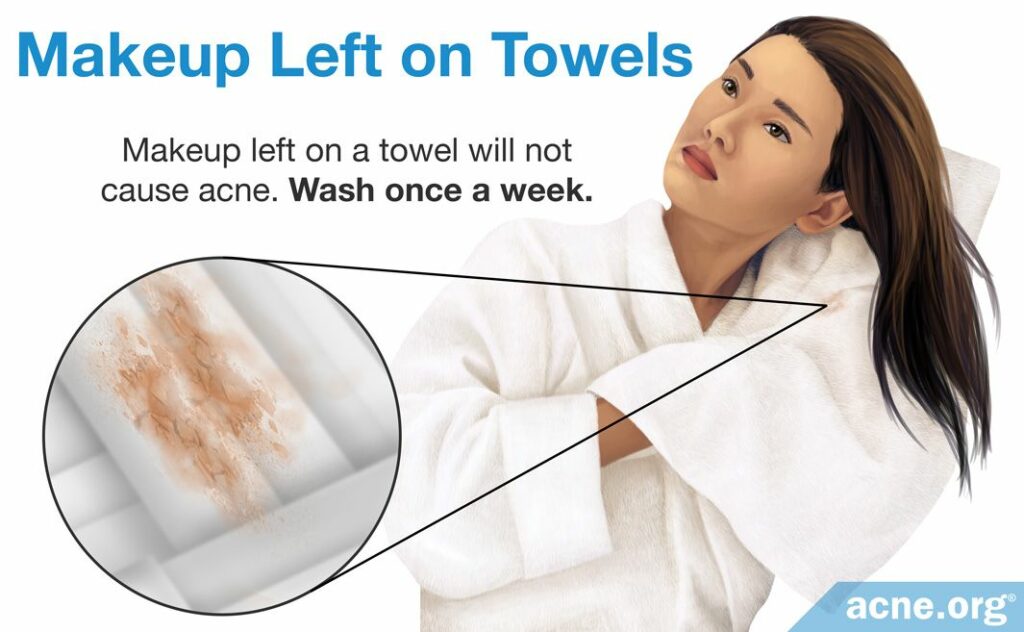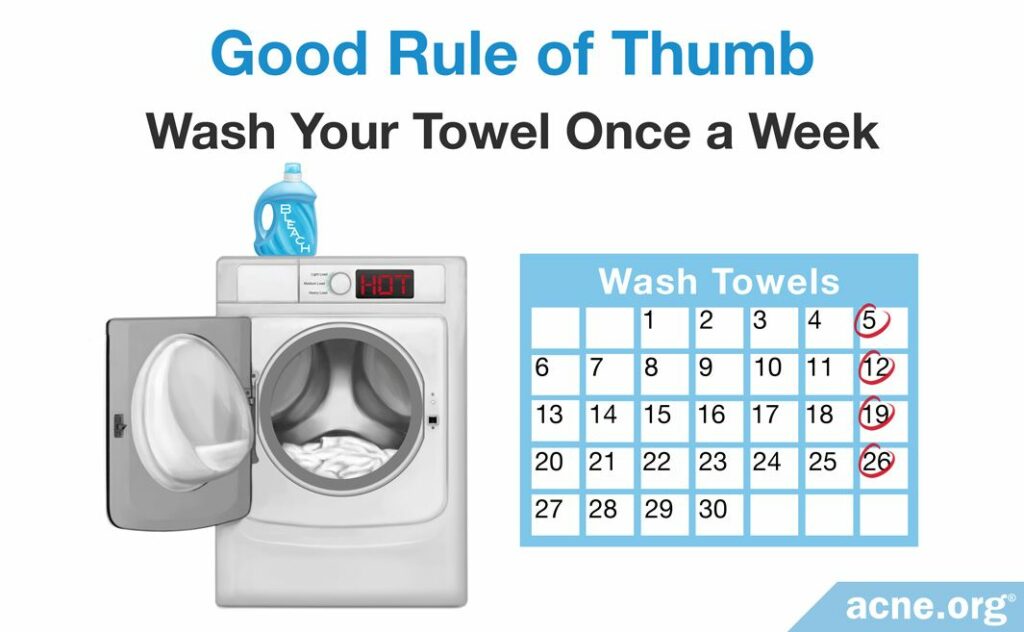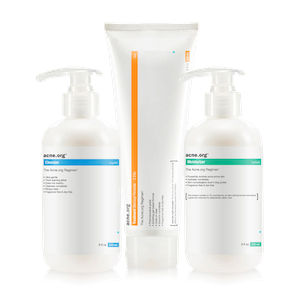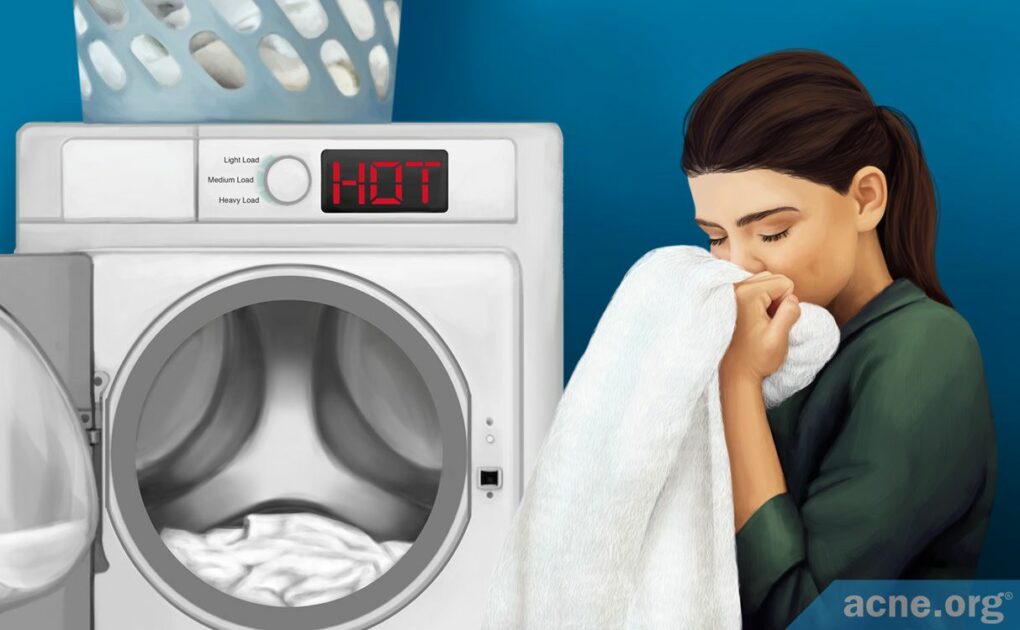A Good Rule of Thumb Is to Wash Your Towel Once a Week in Hot Water

The Essential Info
It’s OK to Reuse Your Towel: After you use your towel and hang it back up, the wet and warm environment can be a breeding ground for microbes (germs like bacteria, viruses, and mold). Since acne is at least in part a bacterial disease, you may wonder whether using the same towel multiple times can contribute to acne. However, the available evidence suggests that when it comes to acne, it is generally safe to reuse your towels. This is because it’s the bacteria inside your skin that we have to be concerned about when it comes to acne–not bacteria on the skin surface.
Also, the small amounts of oil or makeup that can build up on your towel are unlikely to lead to acne.
The Bottom Line: Washing your towel once a week in hot water should be adequate.
___
Stay Gentle When You Dry! Physical irritation of the skin is the real concern when it comes to towels. Physically irritating the skin can lead to more acne, so when you are drying your skin, gently pat dry and do not rub. Let the towel do the work.

The Science
- Can Bacteria from Towels Make Acne Worse?
- Can Oil or Makeup on Towels Make Acne Worse?
- The Real Danger of Towels
- Towels May Spread Infections Unrelated to Acne
- Some Towel Materials Pick up More Microbes than Others
A good rule of thumb is to wash your towel once a week in hot water. But don’t stress about it too much. Used towels are unlikely to contribute to acne. Let’s have a look at exactly why this is the case.
Can Bacteria from Towels Make Acne Worse?

Towels are often damp, and are stored in relatively warm bathroom environments, making for an ideal breeding ground for microbes, including bacteria. This causes some people to be concerned when it comes to acne, because acne bacteria play a role in making acne worse.
However, acne bacteria can only make acne worse when the bacteria are inside skin pores. Bacteria on the skin surface do not cause acne. Therefore, simply transferring bacteria from a towel to the skin surface is unlikely to cause acne or make acne worse.
What is the role of bacteria in acne?
A type of bacteria called C. acnes is involved with the inflammation (redness, swelling, heat, and pain) that we see in most red and sore acne lesions. C. acnes can only survive for prolonged periods where there is no oxygen, such as inside skin pores. Therefore, it cannot survive on a towel. This means we don’t need to be concerned about C. acnes on towels or on the surface of the skin.
Acne typically develops when the following events occur:
- The glands in the skin that make skin oil begin producing more oil
- Skin pores become clogged, trapping the oil inside
- The clogged pores expand because of the trapped skin oil
- Acne bacteria begin to grow inside the clogged pores and feed on the skin oil
- The overgrowth of acne bacteria causes an inflammatory response, and the area becomes red, swollen, and sore1
From these events, we can see that it is bacteria inside pores that contribute to the inflammation inherent in acne. Therefore, we need not concern ourselves with the bacteria that might be living on towels, at least when it comes to acne.
Can Oil or Makeup on Towels Make Acne Worse?
In addition to bacteria, towels can pick up other substances, such as:
- Oils from your skin/hair
- Leftover makeup
However, there is no evidence suggesting that the small amount of oil and/or makeup that a towel may pick up could cause acne.
Oil left on towels from skin/hair

There is no evidence to suggest that oil from skin or hair that accumulates on towels causes or worsens acne.
While some clinical trials on both animal and human skin have shown that certain vegetable oils, like coconut oil, can be pore-clogging, studies have only shown that human skin oil can aggravate acne when it is over-produced inside the skin. Furthermore, even if skin oil on the surface of the skin did contribute to acne formation, the amount that you would likely get on your skin from drying with a towel is minuscule, and unlikely to cause a problem.
One exception: Oil acne
If you work with so-called “cutting” oils, such as the grease used in automobile repair or the grease that factories use to lubricate machines, your towels may pick up these oils, and if these specific types of oils end up on acne-prone areas of your body, they may cause a specific type of acne referred to as oil acne.
Oil acne occurs due to prolonged exposure to cutting oils, which can clog pores and trigger acne.2 Cutting oils are vastly different from olive oil or other cooking oils used in the kitchen, and are also totally different from the oil that our body produces. Most people never encounter cutting oils, so unless you work in an automobile repair shop or work closely with grease in a factory setting, you are likely safe from oil acne. On the other hand, if you do get cutting oils on your towel, you will want to wash that towel immediately.3
Makeup left on towels

Acne caused by makeup is common and even has its own name: acne cosmetica.3 However, the amount of makeup that might end up on your towel is likely extremely small, so the likelihood that this will cause a problem is slight.
The Real Danger of Towels: Rubbing the Skin with Towels Can Physically Irritate the Skin and Make Acne Worse

Acne-prone skin tends to have an impaired skin barrier. This means the skin’s outermost layer is damaged and loses water more easily than healthy skin.
Anything that physically irritates the skin can further damage this skin barrier and lead to more acne.
Towels can irritate the skin when you aren’t careful. Therefore, it is important to gently pat your skin dry, and avoid any rubbing.
Researchers have conducted a study to test how different ways of drying the skin with a towel might damage the skin.

The study, published in 2002 in the journal Contact Dermatitis, used Korean volunteers. After soaking their forearms (up to the elbow) in warm water for five minutes, the volunteers scrubbed their forearms with a rough towel. The researchers then tested the skin to see how waterproof it was. They found that the skin’s water-holding capacity decreased after the scrubbing and did not return to normal for several days. In other words, scrubbing with a rough towel reduces the skin’s ability to stay hydrated for several days.4 This could directly lead to increased acne, which is why the dermatological community agrees that acne-prone people should treat their skin gently and prevent damage to the skin’s barrier. So when using a towel, use it very gently.
As a side note, roughly washing the skin, especially with harsh soaps, can also damage the skin’s barrier.5 So be sure to also stay very gentle when washing your skin. Use only a gentle cleanser made specifically for the face, and avoid soap altogether.
Towels May Spread Infections Unrelated to Acne
As we have seen, microbes from reused or shared towels are unlikely to cause acne or make acne worse. On the other hand, towels can spread other infections. Therefore, it is a bad idea to share towels with family members who have an active infection like a cold, the flu, or a skin infection.
It is important to keep in mind that most studies looking at microbes on towels have been conducted in a hospital setting. Since hospitals contain a large number of patients with different severe infections, there are many different kinds of microbes in a hospital–many more than in most people’s homes. In addition, because hospital patients are often treated with antibiotics, bacteria that have managed to survive in the hospital are more likely to be antibiotic-resistant. These antibiotic-resistant bacteria are dangerous because they cause infections that are difficult to treat. On the other hand, at home, it is rarer to find antibiotic-resistant bacteria or other microbes that can cause severe infections. Therefore, we must use caution and common sense when applying the results of these studies to a domestic setting.
Expand to read the details of 5 studies looking at microbes on hospital towels

A study published in 2000 in the Journal of Clinical Microbiology looked at how long Staphylococcus, a type of bacteria responsible for staph infections, can survive in cotton towels. The researchers found that the bacteria can survive on the towels for 19 – 21 days.6 As we have seen, bacteria living on towels will not cause acne. However, if a towel containing Staphylococcus comes in contact with an open wound, such as a cut, it is possible for an infection to occur.

A study published in 2008 in The Journal of Hospital Infection found that Bacillus cereus, a type of bacteria that is associated with food poisoning and abdominal pain, can be spread by reused towels in hospitals. Several hospitals in Japan experienced a Bacillus cereus outbreak due to contaminated reused towels.7 Again, it is important to keep in mind that Bacillus cereus is unlikely to be found on used towels at home unless a person in your household is currently sick with a stomach infection.

Similarly, another study, published in 2010 in the Japanese biomedical journal Biocontrol Science, found that hospital towels, which are much more likely to be contaminated with dangerous microbes than towels at home, sometimes contain antibiotic-resistant bacteria called MRSA (methicillin-resistant S. aureus). These bacteria can then be spread between people if the towels are reused. MRSA can potentially cause very serious infections, but these bacteria are typically only found in hospitals.8 Although MRSA will not contribute to acne, it could cause a serious infection that is difficult to treat.

A fourth study, published in 2013 in the American Journal of Infection Control, looked at bacteria found on towels in 10 hospitals in Arizona. The researchers found that even after washing the towels, most of the towels still contained some live bacteria or molds. The authors wrote, “In the 10 hospitals participating in this study, almost all (93%) sampled…towels contained viable microorganisms even after laundering.”9 The researchers identified many species of bacteria and mold on the towels. Several of these species can cause infections in the hospital setting, where people are most vulnerable, but outside the hospital, these bacteria and molds rarely present a problem.9

Finally, a study published in the Journal of Infection and Public Health in 2018 found that different types of antibiotic-resistant bacteria found in hospitals were more likely to survive on 100% cotton towels than on 100% cotton sheets and other textiles. Therefore, the researchers advised hospitals to regularly and systematically launder cotton towels to prevent cross-contamination and infections.10 Again, the types of antibiotic-resistant bacteria found in hospitals are unlikely to be a concern at home.
The findings of these 5 studies suggest that, in a hospital, towels can spread bacteria and molds between people and are a potential source of infections. Therefore, sharing towels or reusing towels that have not been thoroughly washed is risky in a hospital setting.6-10 However, since people who live in the same household typically have the same microbes on their skin, sharing towels among family members at home is generally safe, if the towels are kept dry and washed regularly.
Tip: Letting towels dry properly between uses by hanging them wide in a well-ventilated place can help prevent the growth of bacteria and molds.
Some Towel Materials Pick up More Microbes than Others

Although microbes picked up by towels most likely do not contribute to acne, they may still spread other infections through your household. Therefore, you may wish to buy towels made of materials that are less likely to pick up microbes.
Household towels, particularly bath and hand towels, are usually made of either cotton or a cotton-polyester blend. Based on limited and very weak evidence from studies in hospitals, to reduce the spread of bacteria, the best choice for household towels may be terry cotton, but it is most certainly too early to say this conclusively.
Expand to read details of studies

One study of cotton towels was published in the American Journal of Infection Control in 2010. In this study, the researchers looked at cleaning cloths made of cotton. First, the researchers contaminated clean tiles with two common species of bacteria: Staphylococcus aureus and E. coli. They then used the cloths to wipe the tiles and looked at how well they picked up bacteria. They found that brand-new cotton towels picked up a significant amount of bacteria from surfaces. Next, the researchers washed the cotton towels in hot water 20 times and repeated the test. They found that even after 20 washings, the cotton towels were still very good at picking up bacteria from surfaces.11 Since most household towels are made of cotton and washed many times, if someone in your household has an active infection, his cotton bath and hand towels have probably picked up bacteria from his body and should not be used by other family members.

A second study, published in 2009 in the Journal of Infection in Developing Countries, tried to extend this research and determine which type of cotton is better for reducing the spread of bacteria. To do this, the scientists placed Staphylococcus aureus on towels made of terry, pima, or Egyptian cotton. Then, they determined how much bacteria was transferred from these towels to the hands immediately, or 1, 24, or 48 hours afterwards. The researchers found that even after 48 hours, enough bacteria was still on all 3 types of towels and able to transfer to the hands to potentially cause infection. They also found that:
- Egyptian cotton towels held the most bacteria
- Pima cotton towels held slightly less bacteria
- Terry cotton towels held the least bacteria12
However, this difference was so small that it was not statistically significant. In other words, the fact that the terry cotton towels held the least bacteria may have been due to random chance. Therefore, the researchers were not comfortable concluding that terry cotton towels are the best at reducing the spread of bacteria.12 Thus, if you are thinking of buying new towels, it might be a good idea to choose the less absorbent terry cotton just in case this material has a slight advantage, but there is no need to throw your towels away if they are made of a different kind of cotton. Regardless of which type of cotton your towels contain, you can limit the transmission of bacteria by thoroughly drying your towels between uses and washing them regularly.

The same researchers who compared the 3 kinds of cotton towels also tested the best way to wash the Staphylococcus-covered towels. They found that bleach was the most effective at killing the bacteria on all 3 types of towels.12 Therefore, if a family member is sick, and you are concerned about bacteria being transferred to you through towels, the best way to ensure that your towels are clean is to wash them with bleach. The authors of the study wrote, “Thus, using the least absorbent towels and washing them in bleach on a regular basis may help prevent…infections between family members.”12
References
- Murillo, N. & Raoult, D. Skin microbiota: overview and role in the skin diseases acne vulgaris and rosacea. Future Microbiol 8, 209 – 222 (2013). https://www.ncbi.nlm.nih.gov/pubmed/23374126
- Mathias, C. G. & Cincinnati, M. D. Occupational dermatoses. J Am Acad Dermatol 19, 1107 – 1114 (1988). https://www.jaad.org/article/S0190-9622(98)80005-4/abstract
- Draelos, Z. D. & DiNardo, J. C. A re-evaluation of the comedogenicity concept. J Am Acad Dermatol 54, 507 – 512 (2006). https://www.ncbi.nlm.nih.gov/pubmed/16488305
- Huh, C. H., Seo, K. I., Kim, S. D., Han, J. H. & Eun, H. C. Biophysical changes after mechanical injury of the stratum corneum in normal skin. Contact Dermatitis 46, 24 – 28 (2002). https://europepmc.org/abstract/med/11918583
- Voegeli, D. The effect of washing and drying practices on skin barrier function. J Wound Ostomy Cont Nurs 35, 84 – 90 (2008). https://www.ncbi.nlm.nih.gov/pubmed/18199943
- Neely, A. N. & Maley, M. P. Survival of enterococci and staphylococci on hospital fabrics and plastic. J Clin Microbiol 38, 724 – 6 (2000). https://www.ncbi.nlm.nih.gov/pmc/articles/PMC86187/
- Dohmae, S., Okubo, T., Higuchi, W., Takano, T., Isobe, H., Baranovich, T., Kobayashi, S., Uchiyama, M., Tanabe, Y., Itoh, M. & Yamamoto, T. Bacillus cereus nosocomial infection from reused towels in Japan. J Hosp Infect 69, 361-367 (2008). https://www.ncbi.nlm.nih.gov/pubmed/18602188
- Takei, Y., Yokoyama, K., Katano, H., Tsukiji, M. & Ezaki, T. Molecular epidemiological analysis of methicillin-resistant staphylococci in a neonatal intensive care unit. Biocontrol Sci 15, 129 – 36 (2010). https://www.ncbi.nlm.nih.gov/pmc/articles/PMC3082110/
- Sifuentes, L. Y., Gerba, C. P., Weart, I., Engelbrecht, K. & Koenig, D. W. Microbial contamination of hospital reusable cleaning towels. Am J Infect Control 41, 912 – 915 (2013). https://www.ncbi.nlm.nih.gov/pubmed/23523522
- Hanczvikkel, A. & Tóth, Á. Quantitative study about the role of environmental conditions in the survival capability of multidrug-resistant bacteria. J Infect Public Health 11, 801-806 (2018). https://pubmed.ncbi.nlm.nih.gov/29784578/
- Diab-Elschahawi, M. et al. Evaluation of the decontamination efficacy of new and reprocessed microfiber cleaning cloth compared with other commonly used cleaning cloths in the hospital. Am J Infect Control 38, 289 – 292 (2010). https://www.ncbi.nlm.nih.gov/pubmed/20123151
- Oller, A. R. & Mitchell, A. Staphylococcus aureus recovery from cotton towels. J Infect Dev Ctries 3, 224 – 228 (2009). https://jidc.org/index.php/journal/article/view/19759479
 Acne.org Products
Acne.org Products